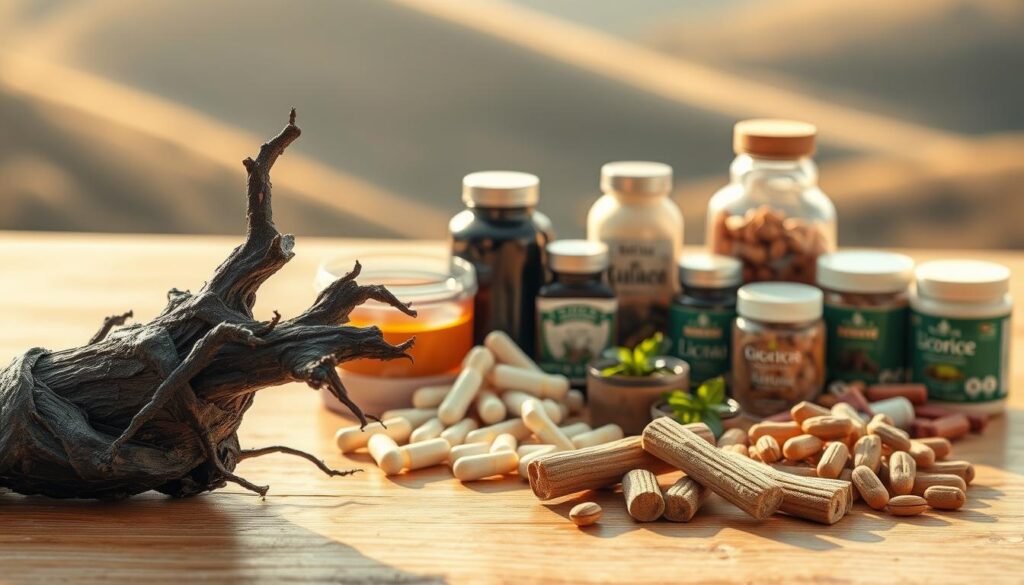Have you ever thought about why licorice has been loved for so long, yet we’re careful about it today? This herb comes from the Glycyrrhiza glabra plant. It has a long history of being used for health, but now we worry about its side effects. Many people love the sweet taste of black licorice, but we’re curious about its true benefits and risks.
In this article, we’ll explore licorice’s uses and benefits. We’ll see why it’s a key part of both old medicine and new sweets.
Key Takeaways
- Licorice has a long history of medicinal use, mainly for digestive issues and coughs.
- Black licorice has glycyrrhizin, which makes it sweet and affects health.
- There are both good and bad effects of licorice to consider.
- The health impact of licorice depends on its form and how much you eat.
- Knowing the good and bad of licorice is key to using it wisely.
Understanding Licorice: A Sweet Historical Perspective
Licorice has a long history, dating back over 4,000 years. It was valued in ancient Egypt and China for its health benefits and flavor. The licorice history shows it was highly respected, even found in pharaohs’ tombs.
The ancient uses of licorice were many. It was used for taste and in healing. Hippocrates praised its healing powers, using it to treat many illnesses. Today, it’s loved for its taste in candies and as a health remedy.
Over time, licorice kept its place in cultures worldwide. It’s used in traditional medicine for stomach issues. Its history highlights its role in both food and medicine, showing its value in many societies.
What Gives Licorice Its Flavor? The Role of Glycyrrhizin

The licorice flavor profile is thanks to glycyrrhizin. This compound makes licorice sweet. It’s found in the licorice plant’s root, making it 30 to 50 times sweeter than sugar.
Glycyrrhizin has been used in medicine for over 4,000 years. It’s known for its health benefits, like reducing inflammation and aiding digestion. This makes glycyrrhizin a popular choice for those looking for natural remedies.
The licorice market is growing fast, expected to hit $1.2 billion by 2026. In the U.S., licorice candy sales are a big deal, worth $300 million yearly. This shows how much people love licorice in their food.
Potential Health Benefits of Licorice Root

Licorice root is known for its many health benefits. It’s used in both traditional and modern herbal remedies. People use licorice to help with various health issues because of its active compounds. Learning about licorice root’s benefits can make you appreciate this herb more.
May Soothe Digestive Issues
Licorice root helps with digestive problems like heartburn and stomach ulcers. It soothes the digestive tract, making digestion more comfortable. For those with chronic digestive issues, licorice remedies can be very helpful.
Traditionally Used for Sore Throats
Licorice has long been used to soothe sore throats and respiratory problems. It coats the throat, reducing irritation. This makes it easier to breathe and helps with coughs or infections.
Possible Anti-Inflammatory Effects
New studies show licorice might have anti-inflammatory properties. It could help with conditions like arthritis. The compounds in licorice may reduce inflammation, leading to less pain and better joint health. For those looking for natural remedies, licorice’s anti-inflammatory effects are worth exploring.
| Health Issue | Licorice’s Role | Potential Benefits |
|---|---|---|
| Digestive Issues | Soothing mucous membranes | Alleviates heartburn, stomach ulcers |
| Sore Throats | Coats and calms irritation | Reduces discomfort and cough |
| Inflammation | Modulates inflammatory responses | Pain relief, improved joint health |
The Risks of Consuming Licorice: What You Should Know

Licorice has its benefits, but it also has risks. Glycyrrhizin, a key part of licorice, can cause health problems if eaten too much. It’s important to know about these risks, whether you like licorice or not.
Impact of Glycyrrhizin on Potassium Levels
Eating too much glycyrrhizin can lower potassium levels too much. This is called hypokalemia. It can happen to people who eat a lot of black licorice.
A 51-year-old man who ate a bag of black licorice jelly beans every day had very low potassium. His blood pressure was also very high, at 174/62. But, his blood pressure went back to normal, 120/86, after he stopped eating the candy.
Potential for High Blood Pressure and Muscle Weakness
Licorice can also cause high blood pressure. A 22-year-old Swedish gym teacher’s blood pressure went up to 240/130 after eating a lot of black licorice. This can lead to muscle weakness and heart problems.
Usually, blood pressure goes back to normal within two weeks after stopping licorice. This shows how important it is to not eat too much of it.
Interactions with Medications
Licorice can also mix badly with some medicines, like blood pressure drugs and diuretics. If you take these medicines, talk to your doctor about licorice. This is to avoid any bad health effects.
Always be careful when taking licorice with other treatments. The risks of glycyrrhizin can grow fast.
| Case Study | Blood Pressure Reading | Potassium Levels | Outcome After Discontinuation |
|---|---|---|---|
| 22-Year-Old Gym Teacher | 240/130 | Not reported | Return to normal within 2 weeks |
| 51-Year-Old Man | 174/62 | Alarming low levels | Normal function after stopping |
| Reader on Antifungal | 180/100 to 190/102 | Not reported | Normalization expected |
Knowing about licorice side effects is key to safe eating. Eating it in moderation can help avoid its dangers.
Licorice and Pregnancy: Safety Considerations

Pregnancy is a special time for expectant mothers. They want to keep their baby safe. Licorice, though tasty, has risks for pregnant women. A compound called glycyrrhizin is the main concern.
Research shows that too much licorice can be dangerous. Women who eat over 500 mg daily face a higher risk of preterm birth. This risk is 2.5 times higher for those who regularly eat licorice.
Also, licorice can lead to lower birth weights. Babies might weigh about 200 grams less if their mothers eat licorice during pregnancy.
Licorice can also harm mothers and babies. It can lower cortisol levels, affecting health. Babies exposed to licorice in the womb are 3.5 times more likely to have behavioral problems.
Health experts stress the need for caution with licorice during pregnancy. They advise pregnant women to follow health guidelines. The European Food Safety Authority suggests a daily limit of 0.4 mg of glycyrrhizin per kg of body weight.
For breastfeeding mothers, licorice safety is key. Some might use it for postpartum issues. But, it’s important to talk to a healthcare provider first. Licorice should be enjoyed with care by both mothers and their babies.
Forms of Licorice: Root, Extracts, and Candies

Licorice comes in many forms, like root, extracts, and candies. Each form has its own taste and health benefits. Knowing the differences helps you make better choices.
Understanding Licorice-Candy Varieties
Licorice candies come in different types. Some use real licorice root, while others use artificial flavors. True black licorice has glycyrrhizin, which can be harmful in large amounts. Knowing the options helps you pick the right treats.
Caution with Black Licorice Treats
Be careful with black licorice candies. They can cause health problems if eaten too much. It’s important to know the differences between licorice products to avoid glycyrrhizin’s effects. Flavored candies without real licorice are safer for those sensitive to glycyrrhizin.
licorice: benefits and cautions unwrapped

Exploring licorice reveals both its health perks and risks. It’s known for its unique taste, thanks to glycyrrhizin. This compound affects its taste and health effects. It’s key to know both sides of licorice for safe use.
Licorice can help with digestion and soothe sore throats. But, too much can cause problems. Glycyrrhizin can mess with potassium levels, leading to muscle weakness or high blood pressure. It’s important to understand how licorice affects people differently.
Knowing licorice’s good and bad sides is vital, more so for certain groups like pregnant women or those on certain meds. By understanding both, you can safely add licorice to your diet.
| Aspect | Benefits | Dangers |
|---|---|---|
| Glycyrrhizin | Enhances flavor, anti-inflammatory properties | Can cause high blood pressure, potassium depletion |
| Medicinal Uses | Digestion relief, sore throat treatment | Potential interactions with certain medications |
| Target populations | General population | Pregnant women, individuals with hypertension |
Licorice Supplements: Benefits and Side Effects

Licorice supplements are popular for their natural benefits. Deglycyrrhizinated licorice (DGL) is a favorite because it removes harmful parts. It’s good for the stomach, helping with heartburn and ulcers.
Exploring Deglycyrrhizinated Licorice (DGL)
DGL is safe because it has less glycyrrhizin. This means less risk of high blood pressure and hormone problems. Studies show it helps with stomach pain.
Unlike regular licorice, DGL doesn’t cause fluid retention or low potassium. But, eating too much licorice can be dangerous, leading to very high blood pressure.
When thinking about licorice supplements, knowing about DGL is key. It’s safer than regular licorice, making it a good choice for many.
Personal Stories: Real-Life Experiences with Licorice

Sharing stories about licorice can be very enlightening. It shows how this unique herb affects different people. Many have found that licorice helps with digestion and sore throats.
For example, someone with chronic throat pain found relief in licorice tea. Just a few sips made a big difference. This shows how licorice can be very helpful.
But, there are also stories of the dangers of too much licorice. Some people have experienced muscle weakness and high blood pressure. These stories warn us to be careful with how much we eat.
These stories remind us to enjoy licorice in moderation. They show that licorice can have both good and bad effects. It’s important to know the risks and enjoy it wisely.
Conclusion
Licorice is a mix of good and bad, affecting your health in different ways. It can help with digestion and soothe sore throats. But, it’s important to know the risks, like how it can affect potassium and blood pressure.
Some people, like those with health issues or pregnant women, should be careful with licorice. Knowing the different types of licorice and its active ingredient, glycyrrhizin, helps you use it safely. Always talk to your doctor before trying licorice to make sure it’s safe for you.
This knowledge helps you enjoy licorice while avoiding any bad effects. It’s all about finding the right balance.

